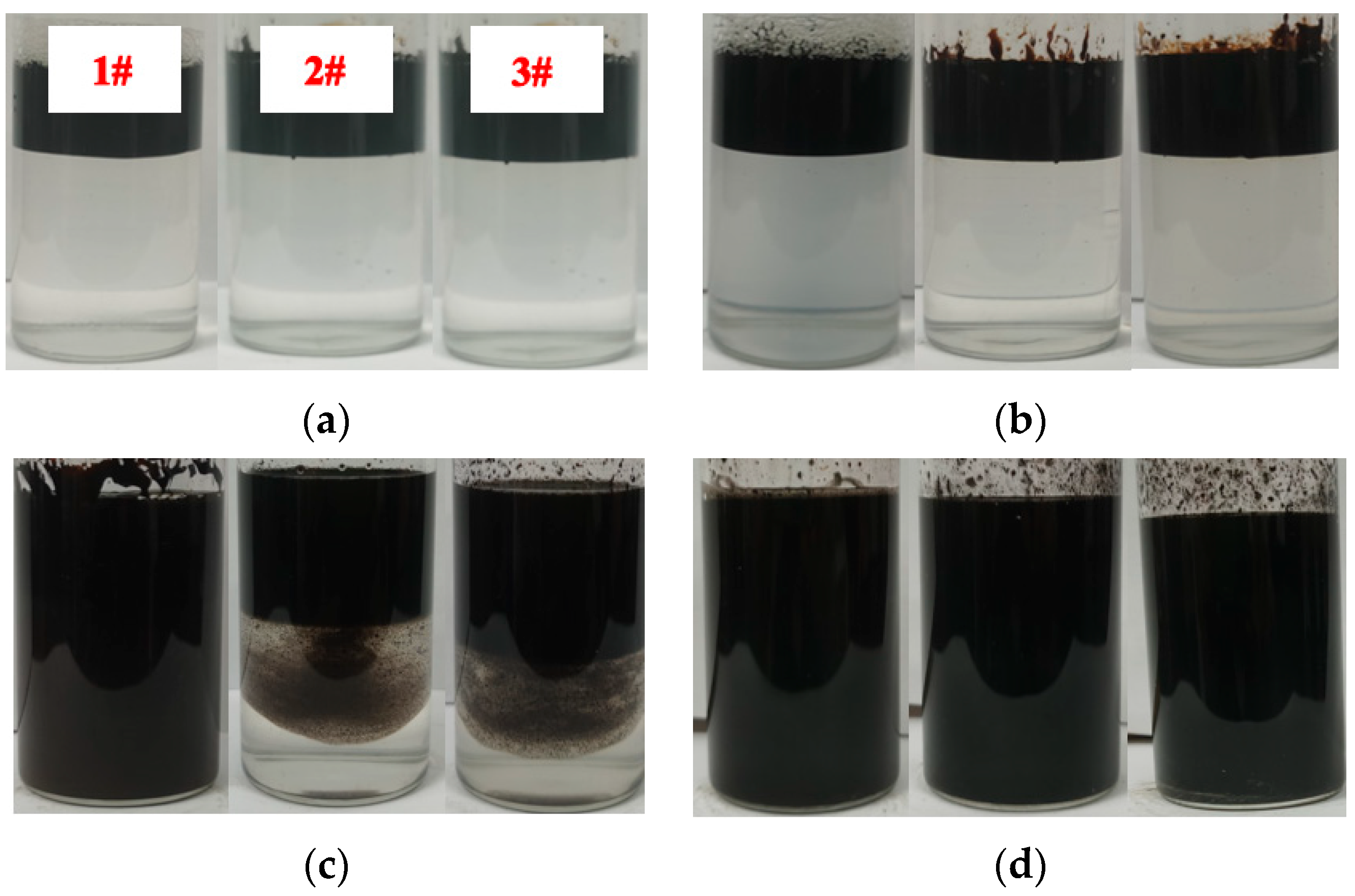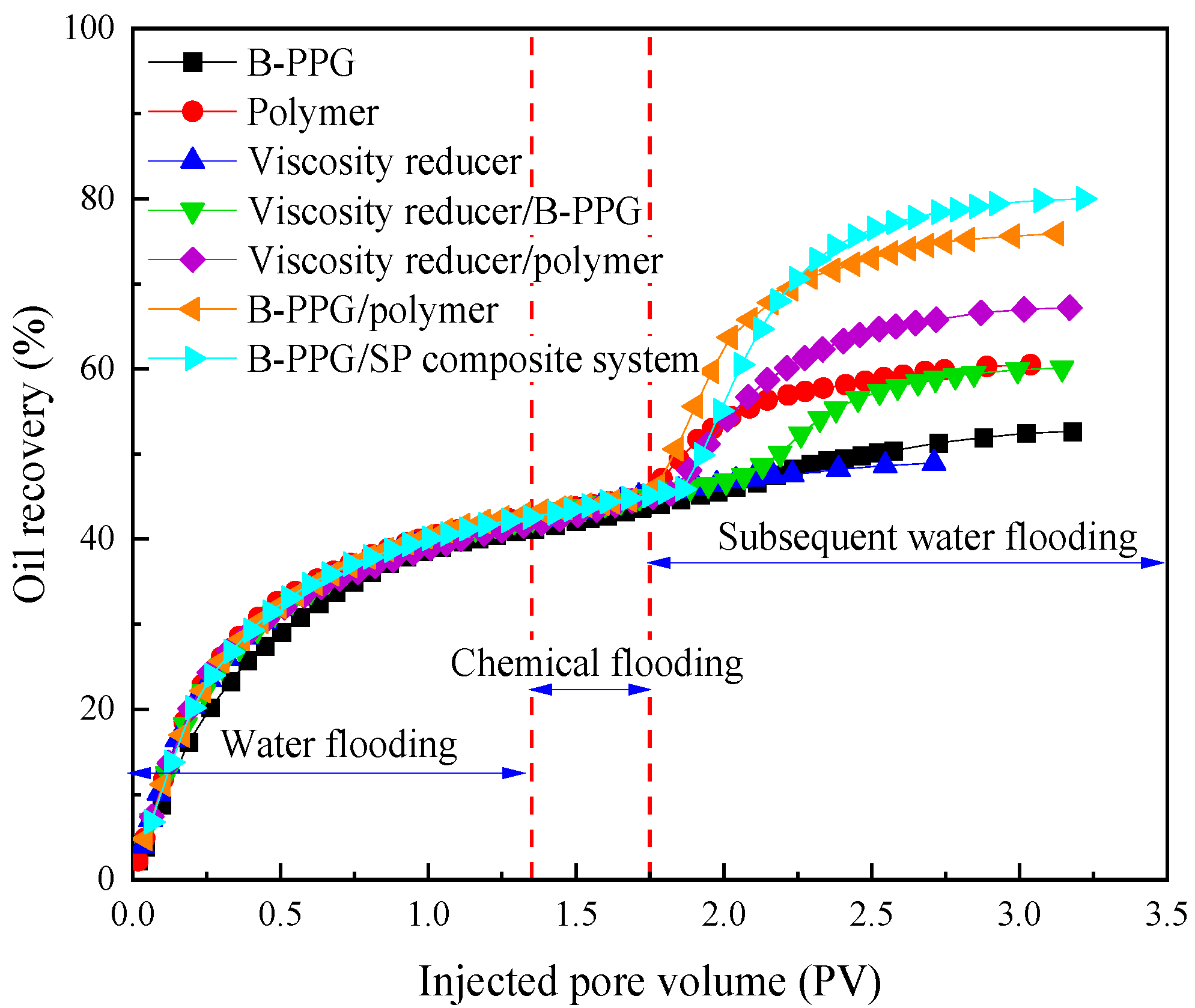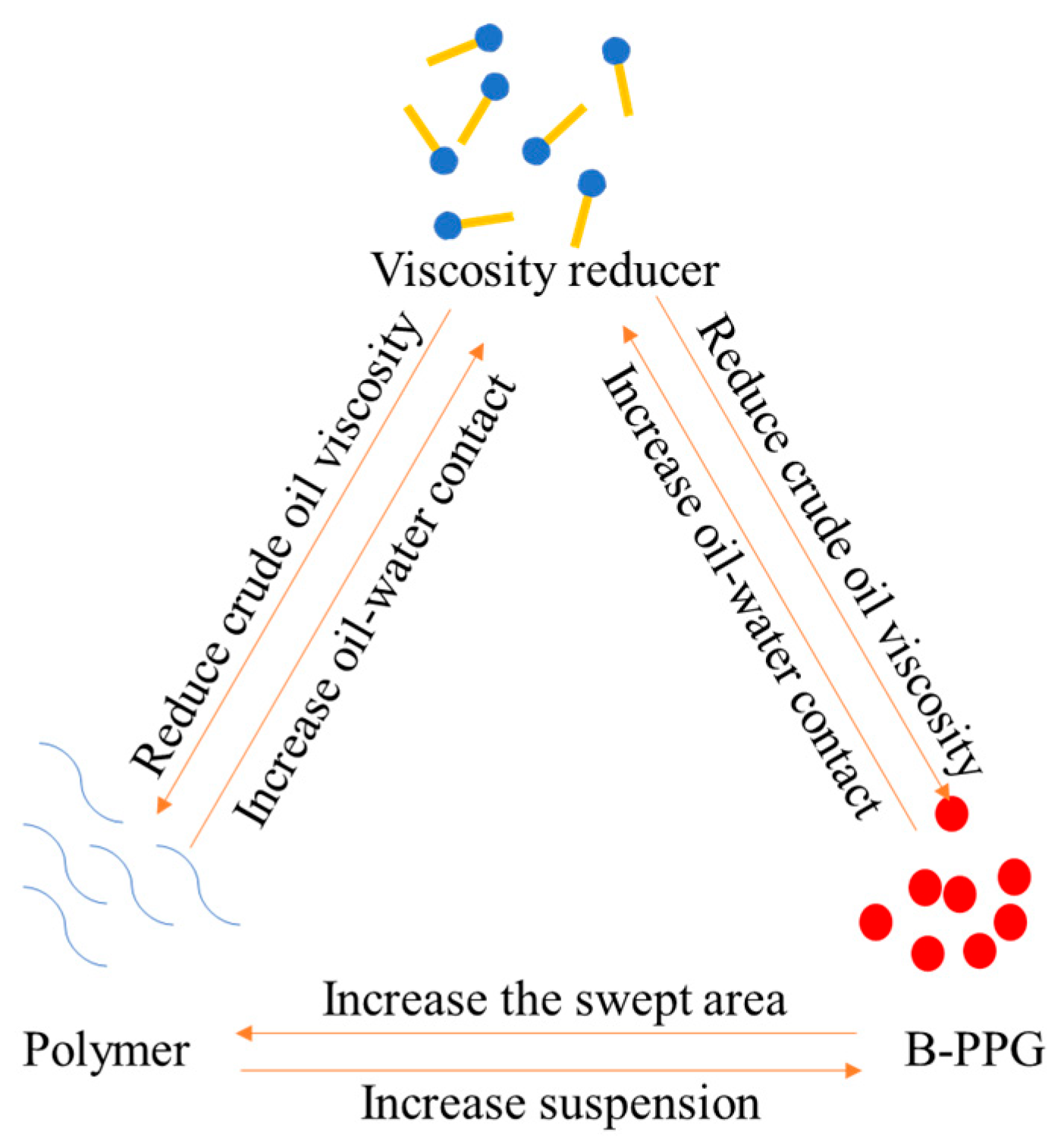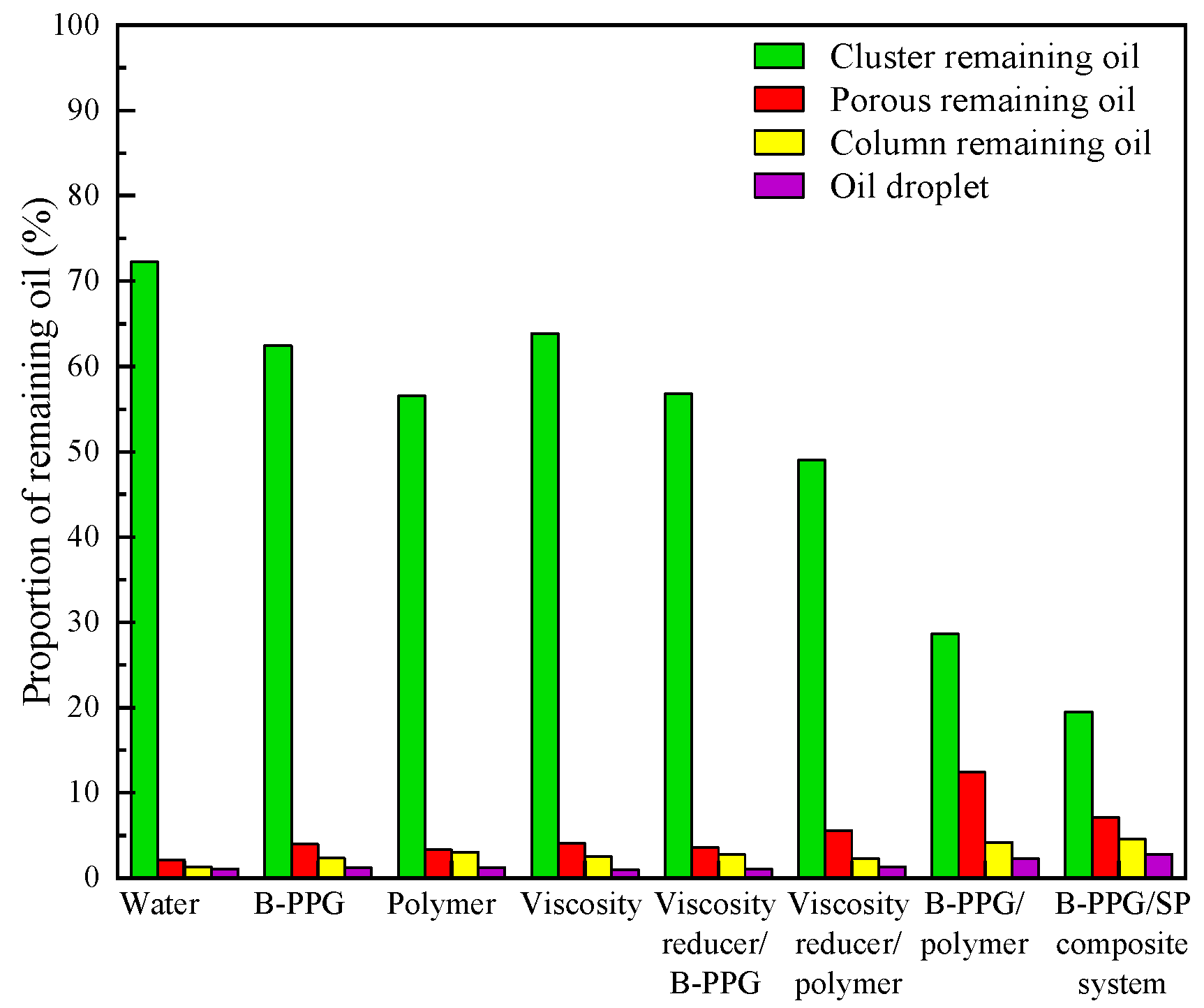Investigation of the Synergistic Effect Between Viscosity Reducer, Polymer and Branched Preformed Particle Gel in Enhanced Oil Recovery for Conventional Heavy-Oil Reservoir
Abstract
1. Introduction
2. Materials and Methods
2.1. Materials
2.2. Methods
2.2.1. Evaluation of Emulsifying Ability and Stability of Composited System
- (1)
- First, 15 mL crude oil was added into 35 mL of prepared viscosity reducer solution in a container.
- (2)
- Then, the sample bottle was placed in a constant-temperature shaker and then was oscillated for 3 min under different oscillation frequency from 0 to 250 r·min−1.
- (3)
- The emulsifying ability of viscosity reducers was determined by observing the state of oil and water in different systems with increasing oscillation frequency.
2.2.2. Sand Pack Flooding Experiment
- (1)
- Preparation of sand pack core: A sand pack core with permeability of 1.0 μm2 was made with 120 mesh quartz sand. Then, water flooding was conducted and the permeability of the sand pack was measured by Darcy’s law.
- (2)
- Heavy-oil saturation period: At 70 °C, the sand pack core was flooded with heavy oil at an injection rate of 0.1 mL·min−1 until the oil was complete at the production end. The original oil saturation of the sand pack was calculated based on the volume of water expelled. Then, the saturated sand pack was sealed in a 70 °C oven for 24 h.
- (3)
- Initial water flooding period: According to the flow chart of the oil displacement experiment, as shown in Figure 2, water flooding was conducted until the water reached the 95% cutoff rate with an injection rate of 0.3 mL·min−1.
- (4)
- Chemical flooding and subsequent water flooding period: Then, 0.4 PV chemical slug was injected into the sand pack care and followed by subsequent water flooding until the water cut reached 98%. The injection pressure and volume of produced water was recorded during different flooding periods, and parameters such as water cut and oil recovery were calculated based on the oil and water volume of the produced liquid.
2.2.3. Microscopic Visualization Flooding Experiment
- (1)
- Heavy-oil saturation period: The synthetic oil was injected into the microscopic visualization model using a high-precision injection pump at an injection rate of 0.01 mL·min−1. The flow rate value was chosen to ensure complete flooding of the porous material without bubbles. Then, the saturated model was aged for 24 h.
- (2)
- Initial water flooding period. The water flooding was conducted until the water cutoff point reached 100% with an injection rate of 0.01 mL·min−1. And the distribution of remaining oil was recorded.
- (3)
- Chemical flooding period: The different chemical slugs were injected with injection rate of 0.01 mL·min−1 after water flooding until the water cutoff reached 100% again. And the distribution of the remaining oil was recorded.
- (4)
- The heavy-oil recovery and microscopic remaining oil proportion after different amounts of chemical flooding were calculated by Xitu image processing software (CIAS-WQT Micro displacement Dynamic Image Analysis System v3.0).
3. Results and Discussion
3.1. Evaluation of Emulsifying Ability and Stability
3.2. The Sand Pack Flooding Experiment Results of Chemical Flooding
3.3. The Microscopic Visualization Flooding Experiment Results
3.4. The Applicable Range of Heavy-Oil Viscosity in the B-PPG/SP Composite System
4. Conclusions
- (1)
- The thickening performance of polymers can increase the injectability of B-PPG, thereby increasing its plugging performance. The synthetic effect of B-PPG and polymer can expand the swept area and the contact between the viscosity reducer and heavy oil. The increase in contact area between viscosity reducers and heavy oil enables the viscosity reducer to better exert emulsification and viscosity reduction effects, thereby reducing the viscosity crude oil. This further reduces the oil–water viscosity ratio and expands the swept area. The synergistic effect between B-PPG, polymer, and viscosity reducer can further expand the swept area and oil displacement efficiency, ultimately enhancing the heavy-oil recovery by 37.8%.
- (2)
- In the proportion of microscopic remaining oil in heavy oil, the proportion of clustered residual oil is particularly high. Therefore, adding B-PPG and polymers to expand the swept area and displace the cluster remaining oil is the most effective method to enhance heavy-oil recovery. The viscosity reducer can effectively displace the dispersed remaining oil within the swept area, thereby further enhancing the oil displacement efficiency.
- (3)
- When the viscosity of crude oil was 657.2 mPa·s, the incremental oil recovery was 36.9%. When the heavy-oil viscosity exceeded 1031.3 mPa·s, the incremental oil recovery declined to 30.2% and was stabilized. The B-PPG/SP composite system can effectively expand the applicable range of heavy-oil viscosity in ordinary heavy-oil reservoirs.
Author Contributions
Funding
Institutional Review Board Statement
Informed Consent Statement
Data Availability Statement
Conflicts of Interest
References
- Liu, Z.; Wang, H.; Blackbourn, G.; Ma, F.; He, Z.; Wen, Z.; Wang, Z.; Yang, Z.; Luan, T.; Wu, Z. Heavy oils and oil sands: Global distribution and resource assessment. Acta Geol. Sin. 2019, 93, 199–212. [Google Scholar] [CrossRef]
- Guo, K.; Li, H.; Yu, Z. In-situ heavy and extra-heavy oil recovery: A review. Fuel 2016, 185, 886–902. [Google Scholar] [CrossRef]
- Alvarado, V.; Manrique, E. Enhanced Oil Recovery: An Update Review. Energies 2010, 3, 1529–1575. [Google Scholar] [CrossRef]
- Zhao, Q.; Guo, L.; Huang, Z.; Chen, L.; Jin, H.; Wang, Y. Experimental investigation on enhanced oil recovery of extra heavy oil by supercritical water flooding. Energy Fuels 2018, 32, 1685–1692. [Google Scholar] [CrossRef]
- Deng, R.; Dong, J.; Dang, L. Numerical simulation and evaluation of residual oil saturation in waterflooded reservoirs. Fuel 2025, 384, 134018. [Google Scholar] [CrossRef]
- Larisa, A.S.; Sergey, O.I. Effect of enhanced oil recovery on the composition and rheological properties of heavy crude oil. J. Pet. Sci. Eng. 2021, 203, 108641. [Google Scholar]
- Mai, A.; Bryan, J.; Goodarzi, N.; Kantzas, A. Insights into Non-Thermal Recovery of Heavy Oil. J. Can. Pet. Technol. 2009, 48, 27–35. [Google Scholar] [CrossRef]
- Guo, C.; Qu, F.; Liu, Y.; Nian, X.; Chen, Z.; Zou, Y. Numerical Simulation of Steam Injection for Heavy Oil Thermal Recovery. Energy Procedia 2017, 105, 3936–3946. [Google Scholar]
- Mandal, A.; Keka, O. Enhanced Oil Recovery: Mechanisms, Technologies and Feasibility Analyses; CRC Press: Boca Raton, FL, USA, 2023. [Google Scholar]
- Zhao, D.; Wang, J.; Gates, I. Thermal recovery strategies for thin heavy oil reservoirs. Fuel 2014, 117, 431–441. [Google Scholar] [CrossRef]
- Sun, J.; Zhang, F.; Wu, Y.; Liu, G.; Li, X.; Su, H.; Zhu, Z. Overview of emulsified viscosity reducer for enhancing heavy oil recovery. IOP Conf. Ser. Mater. Sci. Eng. 2019, 479, 012009. [Google Scholar] [CrossRef]
- Yaser, A.; Meysam, H.; Behzad, V.; Asghar, G. Applications of nanoparticles during chemical enhanced oil recovery: A review of mechanisms and technical challenges. J. Mol. Liq. 2024, 415, 126287. [Google Scholar]
- Ahmadi, M.; Shadizadeh, S. Nano-surfactant flooding in carbonate reservoirs: A mechanistic study. Eur. Phys. J. Plus 2017, 132, 246. [Google Scholar] [CrossRef]
- Jia, H.; Zhou, H.; Jia, C.; Zeng, P.; Zhang, F.; Xie, M. Controlled synthesis of gold nanorings with structural defects assisted by elastic induction of mixed surfactants. CrystEngComm 2015, 17, 6053–6058. [Google Scholar] [CrossRef]
- Dong, M.; Liu, Q.; Li, A. Displacement mechanisms of enhanced heavy oil recovery by alkaline flooding in a micromodel. Particuology 2012, 10, 298–305. [Google Scholar] [CrossRef]
- Pei, H.; Zhang, G.; Ge, J.; Jin, L.; Ma, C. Potential of alkaline flooding to enhance heavy oil recovery through water-in-oil emulsification. Fuel 2013, 104, 284–293. [Google Scholar] [CrossRef]
- He, H.; Ning, W.; Pei, H.; Chen, R.; Tian, Y.; Liu, Y.; Zuo, Q. Insights into Enhanced Oil Recovery by Viscosity Reduction Combination Flooding System for Conventional Heavy Oil Reservoir. Processes 2025, 13, 618. [Google Scholar] [CrossRef]
- He, H.; Yang, Y.; Liu, H.; Zhang, X.; Fu, J.; Hu, J. Insights into the preparation and mechanism of Non-Alkali viscosity reducer for enhancing heavy oil recovery under Low-Shear condition. J. Mol. Liq. 2024, 410, 125601. [Google Scholar] [CrossRef]
- Lemahieu, G.; Ontiveros, J.; Souza, N.; Molinier, V.; Aubry, J. Fast and accurate selection of surfactants for enhanced oil recovery by dynamic Salinity-Phase-Inversion (SPI). Fuel 2021, 289, 119928. [Google Scholar] [CrossRef]
- Wang, F.; Xu, H.; Liu, Y.; Jiang, Y.; Wu, C. Experimental Study on the Enhanced Oil Recovery Mechanism of an Ordinary Heavy Oil Field by Polymer Flooding. ACS Omega 2023, 8, 14089–14096. [Google Scholar] [CrossRef]
- Gao, C. Scientific research and field applications of polymer flooding in heavy oil recovery. J. Pet. Explor. Prod. Technol. 2011, 1, 65–70. [Google Scholar] [CrossRef]
- Chen, L.; Zhang, G.; Ge, J.; Jiang, P.; Tang, J.; Liu, Y. Research of the heavy oil displacement mechanism by using alkaline/surfactant flooding system. Colloids Surf. A Physicochem. Eng. Asp. 2013, 434, 63–71. [Google Scholar] [CrossRef]
- Denney, D. Enhanced Heavy-Oil Recovery by Alkali/Surfactant Flooding. J. Pet. Technol. 2008, 60, 91–93. [Google Scholar] [CrossRef]
- Ding, M.; Wang, Y.; Yuan, F.; Zhao, H.; Li, Z. A comparative study of the mechanism and performance of surfactant- and alkali-polymer flooding in heavy-oil recovery. Chem. Eng. Sci. 2020, 219, 115603. [Google Scholar] [CrossRef]
- Fu, L.; Zhang, G.; Ge, J.; Liao, K.; Pei, H.; Jiang, P.; Li, X. Study on organic alkali-surfactant-polymer flooding for enhanced ordinary heavy oil recovery. Colloids Surf. A Physicochem. Eng. Asp. 2016, 508, 230–239. [Google Scholar] [CrossRef]
- Ding, B.; Zhang, G.; Ge, J.; Liu, X. Research on Mechanisms of Alkaline Flooding for Heavy Oil. Energy Fuels 2010, 24, 6346–6352. [Google Scholar] [CrossRef]
- Liu, Q.; Dong, M.; Ma, S.; Tu, Y. Surfactant enhanced alkaline flooding for Western Canadian heavy oil recovery. Colloids Surf. A Physicochem. Eng. Asp. 2007, 293, 63–71. [Google Scholar] [CrossRef]
- Wu, Z.; Yue, X.; Cheng, T.; Yu, J.; Yang, H. Effect of viscosity and interfacial tension of surfactant–polymer flooding on oil recovery in high-temperature and high-salinity reservoirs. J. Pet. Explor. Prod. Technol. 2014, 4, 9–16. [Google Scholar] [CrossRef]
- Zhang, Z.; Wang, Y.; Ding, M.; Mao, D.; Chen, M.; Han, Y.; Liu, Y.; Xue, X. Effects of viscosification, ultra-low interfacial tension, and emulsification on heavy oil recovery by combination flooding. J. Mol. Liq. 2023, 380, 121698. [Google Scholar] [CrossRef]
- Xue, X.; Zhu, S.; Ma, X.; Zhang, S.; Yang, S.; Huang, Z.; Xu, M.; Huang, H. Enhancing heavy-oil displacement efficiency through viscoelasticity of polymer solution by investigating the viscosity limit of crude oil: An experimental study. Energy Sci. Eng. 2024, 12, 2493–2504. [Google Scholar] [CrossRef]
- Goudarzi, A.; Zhang, H.; Varavei, A.; Taksaudom, P.; Hu, Y.; Delshad, M.; Bai, B.; Sepehrnoori, K. A laboratory and simulation study of preformed particle gels for water conformance control. Fuel 2015, 140, 502–513. [Google Scholar] [CrossRef]
- Kang, W.; Shao, S.; Yang, H.; Chen, C.; Hou, X.; Huang, Z.; Zhao, H.; Aidarova, S.; Gabdullin, M. The effect of stepwise increasing of water injection rates on enhanced oil recovery after preformed particle gel treatment. J. Pet. Sci. Eng. 2019, 182, 106239. [Google Scholar] [CrossRef]
- Farasat, A.; Sefti, M.; Sadeghnejad, S.; Saghafi, H. Mechanical entrapment analysis of enhanced preformed particle gels (PPGs) in mature reservoirs. J. Pet. Sci. Eng. 2017, 157, 441–450. [Google Scholar] [CrossRef]
- Saghafi, H. Retention characteristics of enhanced preformed particle gels (PPGs) in porous media: Conformance control implications. J. Pet. Sci. Eng. 2018, 166, 962–968. [Google Scholar] [CrossRef]
- Xu, L.; Qiu, Z.; Gong, H.; Zhu, C.; Sang, Q.; Li, Y.; Dong, M. Synergy of microbial polysaccharides and branched-preformed particle gel on thickening and enhanced oil recovery. Chem. Eng. Sci. 2019, 208, 115138. [Google Scholar] [CrossRef]
- Pi, Y.; Liu, J.; Cao, R.; Liu, L.; Ma, Y.; Gu, X.; Li, X.; Fan, X.; Zhao, M. Visualized Study on a New Preformed Particle Gels (PPG) +Polymer System to Enhance Oil Recovery by Oil Saturation Monitoring Online Flooding Experiment. Gels 2023, 9, 81. [Google Scholar] [CrossRef] [PubMed]
- Pi, Y.; Su, Z.; Cao, R.; Li, B.; Liu, J.; Fan, X.; Zhao, M. Experimental Study on Enhanced Oil Recovery of PPG/ASP Heterogeneous System after Polymer Flooding. Gels 2023, 9, 427. [Google Scholar] [CrossRef]
- Sun, H. Application of pilot test for well pattern adjusting heterogeneous combination flooding after polymer flooding-case of Zhongyiqu Ng3 block, Gudao oilfield. Pet. Geol. Recovery Effic. 2014, 21, 1–4+111. [Google Scholar]
- Ding, M.; Wang, Y.; Li, Z.; Zhong, D.; Yuan, F.; Zhu, Y. The role of IFT and emulsification in recovering heavy oil during S/SP flooding. J. Ind. Eng. Chem. 2019, 77, 198–208. [Google Scholar] [CrossRef]













| No. | Chemical Slug | Water Flooding Recovery/% | Oil Recovery/% | Incremental Oil Recovery/% |
|---|---|---|---|---|
| 1# | B-PPG | 43.3 | 54.7 | 11.4 |
| 2# | Polymer | 42.7 | 60.5 | 17.8 |
| 3# | Viscosity reducer | 42.0 | 49.0 | 7.0 |
| 4# | Viscosity reducer/B-PPG | 42.4 | 60.1 | 17.7 |
| 5# | Viscosity reducer/polymer | 41.9 | 67.2 | 25.3 |
| 6# | B-PPG/polymer | 42.9 | 75.9 | 33.0 |
| 7# | B-PPG/SP composite system | 42.2 | 80.0 | 37.8 |
| No. | Chemical Slug | Water Flooding Recovery/% | Oil Recovery/% | Incremental Oil Recovery/% |
|---|---|---|---|---|
| 1# | B-PPG | 22.8 | 30.1 | 7.3 |
| 2# | Polymer | 24.4 | 35.9 | 11.5 |
| 3# | Viscosity reducer | 22.3 | 28.6 | 6.3 |
| 4# | Viscosity reducer/B-PPG | 23.8 | 35.9 | 12.1 |
| 5# | Viscosity reducer/polymer | 22.0 | 41.9 | 19.9 |
| 6# | B-PPG/polymer | 22.5 | 52.6 | 30.1 |
| 7# | B-PPG/SP composite system | 23.2 | 66.1 | 42.9 |
| No. | Chemical Slug | Heavy Oil Viscosity /mPa·s (70 °C) | Water Flooding Recovery/% | Oil Recovery/% | Incremental Oil Recovery/% |
|---|---|---|---|---|---|
| 1# | 0.4 PV B-PPG/SP composite system | 53.9 | 44.9 | 87.6 | 42.7 |
| 2# | 107.3 | 44.3 | 85.8 | 41.5 | |
| 3# | 314.6 | 42.7 | 81.1 | 38.4 | |
| 4# | 446.8 | 42.2 | 80.0 | 37.8 | |
| 5# | 657.2 | 41.7 | 78.6 | 36.9 | |
| 6# | 1031.3 | 38.5 | 68.7 | 30.2 | |
| 7# | 2471.3 | 35.2 | 60.7 | 25.5 |
Disclaimer/Publisher’s Note: The statements, opinions and data contained in all publications are solely those of the individual author(s) and contributor(s) and not of MDPI and/or the editor(s). MDPI and/or the editor(s) disclaim responsibility for any injury to people or property resulting from any ideas, methods, instructions or products referred to in the content. |
© 2025 by the authors. Licensee MDPI, Basel, Switzerland. This article is an open access article distributed under the terms and conditions of the Creative Commons Attribution (CC BY) license (https://creativecommons.org/licenses/by/4.0/).
Share and Cite
Yang, Y.; He, H.; Pei, H.; Zhou, W.; Ke, W.; Zhang, X.; Jiang, C. Investigation of the Synergistic Effect Between Viscosity Reducer, Polymer and Branched Preformed Particle Gel in Enhanced Oil Recovery for Conventional Heavy-Oil Reservoir. Processes 2025, 13, 1206. https://doi.org/10.3390/pr13041206
Yang Y, He H, Pei H, Zhou W, Ke W, Zhang X, Jiang C. Investigation of the Synergistic Effect Between Viscosity Reducer, Polymer and Branched Preformed Particle Gel in Enhanced Oil Recovery for Conventional Heavy-Oil Reservoir. Processes. 2025; 13(4):1206. https://doi.org/10.3390/pr13041206
Chicago/Turabian StyleYang, Yuanchao, Hong He, Haihua Pei, Wei Zhou, Wenli Ke, Xueshuo Zhang, and Cao Jiang. 2025. "Investigation of the Synergistic Effect Between Viscosity Reducer, Polymer and Branched Preformed Particle Gel in Enhanced Oil Recovery for Conventional Heavy-Oil Reservoir" Processes 13, no. 4: 1206. https://doi.org/10.3390/pr13041206
APA StyleYang, Y., He, H., Pei, H., Zhou, W., Ke, W., Zhang, X., & Jiang, C. (2025). Investigation of the Synergistic Effect Between Viscosity Reducer, Polymer and Branched Preformed Particle Gel in Enhanced Oil Recovery for Conventional Heavy-Oil Reservoir. Processes, 13(4), 1206. https://doi.org/10.3390/pr13041206








